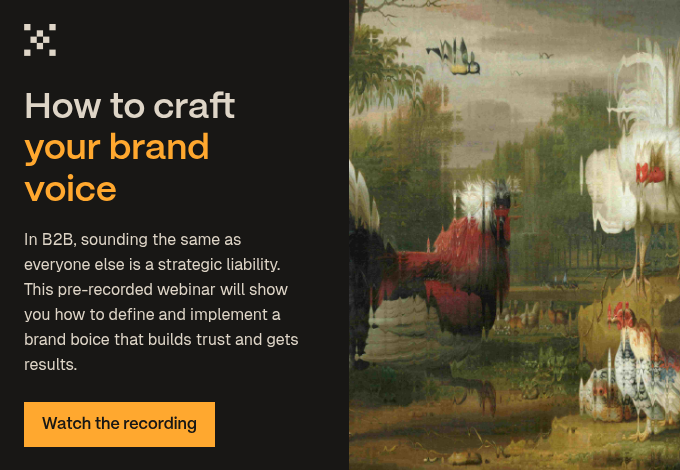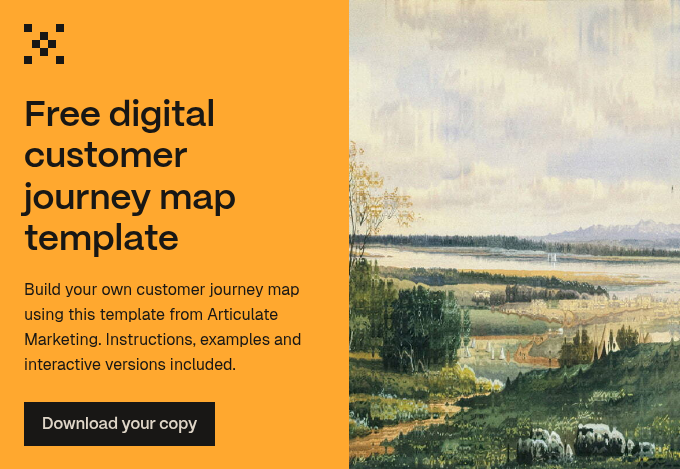Batman vs. The Joker. Sherlock Holmes vs. Moriarty. Road Runner vs. Wiley Coyote. Audiences can’t get enough of these classic rivalries. They make for memorable and compelling stories. And we can learn a lesson as marketers: making enemies is a brilliant brand strategy.
When expert David Brier explains branding to people, he talks about the enemies of branding. These are the clichés of the category — the common and overused visuals, statements and promises. He uses a four-word definition of effective branding: “the art of differentiation.”
So, when we’re talking about making enemies as a B2B brand, the enemy in question is the generic, bland, dull blah blah blah.
Gartner has found that 46 percent of customers can’t tell the difference between most brands’ digital experiences, demonstrating the extent of the boring brand problem. Businesses must be willing to step out of their comfort zone and — frankly — risk alienating some people in order to connect more deeply with prospective buyers. Marmite did it so well that the word itself became synonymous with this brand strategy.
If you don’t have any enemies, your brand isn’t distinctive enough. Or, to put it another way, if you try to please everybody, you excite nobody.
What ‘making enemies’ actually means
Before we dig into the benefits of making enemies as part of your brand strategy, let’s clarify what we’re NOT suggesting you do:
- Ignore or attack customers who don’t like your brand
- Flout the rules and regulations of your industry
- Call out your competitors (unless you do it in a specific way… more on that later)
- Buy a social media company, re-platform hate speech and insult your biggest advertisers (cough)
‘Making enemies’ is about finding a distinctive position for your brand, which necessarily opposes something, without the pendulum swinging to any extremes.
That last part is important to keep in mind. Even businesses operating in the slimmest verticals need to resonate with a range of buyers from different walks of life. And it’s harder to do this if the position you adopt makes most of them feel uncomfortable or unwelcome in your brand’s presence. (Take the GAP logo backlash as an example. The logo change was so unwelcome, they switched it back in just six days.)
The battle of the brands
OK so we’re not actually fighting anyone… But pinpointing your brand’s “enemies” requires careful thought and an understanding of your brand purpose (unlike in comics, where all you need is a police scanner and an unwavering sense of justice).
By defining the reason your business exists outside of making a profit, you will reveal the parameters of your brand strategy: what it contains and what it excludes. This will help you solidify your stance and your approach.
Here are three angles on how to make your brand strategy more distinctive:
1. The threat to your cause
Every business has a cause at its core. Some are more obvious, like environmental tech companies trying to minimise the negative impact of commercial tech usage. But, having a cause doesn’t always mean environmental or social missions. Every company is founded on a cause related to its customers — IT companies strive to rid other businesses of inefficient processes, for example.
As an example, let’s look at businesses that were founded to tackle the negative impact of certain industries, like environmental tech companies. In this case, your enemy is the threat to your cause. This will likely be things like outdated and damaging supply chain practices, fossil-fuelled energy consumption, inefficient computing processes and unmitigated e-waste.
Software company EcoCart is a good example — its enemy is the enormous carbon dioxide (CO₂) emissions caused by e-commerce, which the World Economic Forum estimated could reach 25 million tonnes by 2030. EcoCart makes its opposition clear, with figures showing how much CO₂ they’ve mitigated or avoided to date, as well as detailed case studies for their offsetting projects.
If, like EcoCart, you have a cause worth fighting for, then this one’s for you.
Government health warning: There’s a tricky side to making this kind of enemy, and it’s the pitfall associated with good causes — otherwise known as doom-mongering. Lucky for you, we’ve got a handy blog post to steer you through the positives and pitfalls of purpose-driven branding.
2. The Goliath to your David
Everyone loves an underdog, and it’s no different in the customer journey. One study found that 99 percent of customers can cite specific benefits from working with smaller businesses compared to larger companies. The study covered both B2B and B2C products and services, but the key benefits mentioned can be applied to all small B2B businesses. These include:
- Better, more personal customer service
- Feeling good about supporting smaller companies
- Easier to establish a relationship
So, if you’re a newer brand looking to take on the big players in your market, you could make your competitors the Goliath to your David.
For inspiration, hark back to the Mac vs. PC platform that Apple launched in the 2000s against competitor Microsoft. Today, the tech giants wrestle for the title of ‘Most valuable company in the world’, but it wasn’t long ago that Apple was the plucky challenger.
In this instance, Apple was going after Microsoft’s share of the B2C market. But, the lesson for B2B brands is this — standing in direct opposition to a competitor positions you as an alternative that audiences may not have considered before. If you’re that newer, agile counterpart to the lumbering incumbents, then this angle is perfect for you.
3. The generic to your specialism
Complexity as a barrier to entry (and effectiveness) is still a problem in many B2B sectors. So, some companies have innovated to provide simpler solutions for a wider range of users. A good example of this is Canva. It plugged a gap in the market for smaller businesses who wanted to create their own designs, but didn’t have the budget or capabilities to wield the Adobe Suite.
But, simpler isn’t always better. What if your audience is crying out for more sophisticated options and expertise in a sea of broad-appeal solutions?
In this case, your enemies are the generic to your specialism. Where competitors go wide, you go deep. This is because simplicity isn’t always reassuring when your work is unavoidably complex.
Let’s take one of our clients as an example. Planisware is a SaaS company that provides cloud solutions for project and portfolio management. Its software was built to serve larger organisations who need to strategically manage multiple, complex projects or programs concurrently — think global food and beverage brands or pharmaceutical companies.
Compare them to generic competitors like Monday or Asana. These are popular and user-friendly options for project management, but they don’t offer integration with clinical trial management systems or mapping and visualisation of IT portfolios.
Planisware’s specialism means it stands in opposition to more rudimentary alternatives. It leans into the capabilities companies can develop with its sophisticated features, and tackles the tough challenges facing its customers. It doesn’t claim to be easy-breezy. It’s a serious platform with serious capabilities. If that story resonates with you, then this could be where you stand your ground, too.
How do you know where the line is?
Now you’ve got your enemy in your sights. But, there’s one more decision to make: how far do you want to go in communicating this dynamic? What is the line you won’t cross?
The answer to this question is individual to your business. It will depend on:
The rules of your industry. This refers to both official rules (regulations) and unofficial rules (cultural norms). Breaking official rules is off the table. Breaking unofficial rules can be a great idea for disrupting your market and reaching underserved audiences. Take Dead Happy, for example. The unofficial rule of their industry is that life insurance is serious. So, they decided to show the funny side of life (and death) in their branding instead. Just remember, before you go breaking all the rules, you still need to consider what makes sense and garners trust in your industry.
Your customers. Some customer personas will be more engaged by certain rivalries than others. For example, small business owners might be more engaged by the notion of supporting fellow Davids vs. Goliaths. Or, recently promoted C-level stakeholders might be motivated by disruption stories that resonate with former frustrations from their previous, more junior roles.
Your appetite for risk. If it’s a competitor under fire, you need to think about how they might react, or retaliate. If your business’s appetite for risk is lower, you could consider a more subtle approach that avoids calling them out by name. Rather, you take a stance against the industry norms. If you’re comfortable with more risk and you’ve got the resources to employ bespoke legal guidance, you can explore some cheekier approaches.
Dare to be divisive
Put it this way. You’re going to make enemies. It’s inevitable. Not everyone is going to like your business no matter what you do. Being as bland and inoffensive as possible is not the answer to that problem. You might as well make the right enemies and be intentional about it.
It’s up to you to refine your approach based on your customers, your industry culture and your strengths as an organisation. Remember — you can’t and don’t need to please everyone. You want to stand out because you stand for something different.
It’s a daunting thought to face down your enemies alone. But every great hero has a trusty sidekick they can rely on for counsel and field support. Holy socks, Batman, that’s us — your B2B tech marketing partner, Articulate Marketing. Book a chat with us today.

 Posted by
Maddie Saunders
Posted by
Maddie Saunders
.jpg?width=1600&height=800&name=museum-of-new-zealand-te-papa-tongarewa-Gfsy6hG5z8g-unsplash%20(1).jpg)




-1.jpg?width=400&height=250&name=art-institute-of-chicago-wasoFWW8G1c-unsplash%20(1)-1.jpg)
